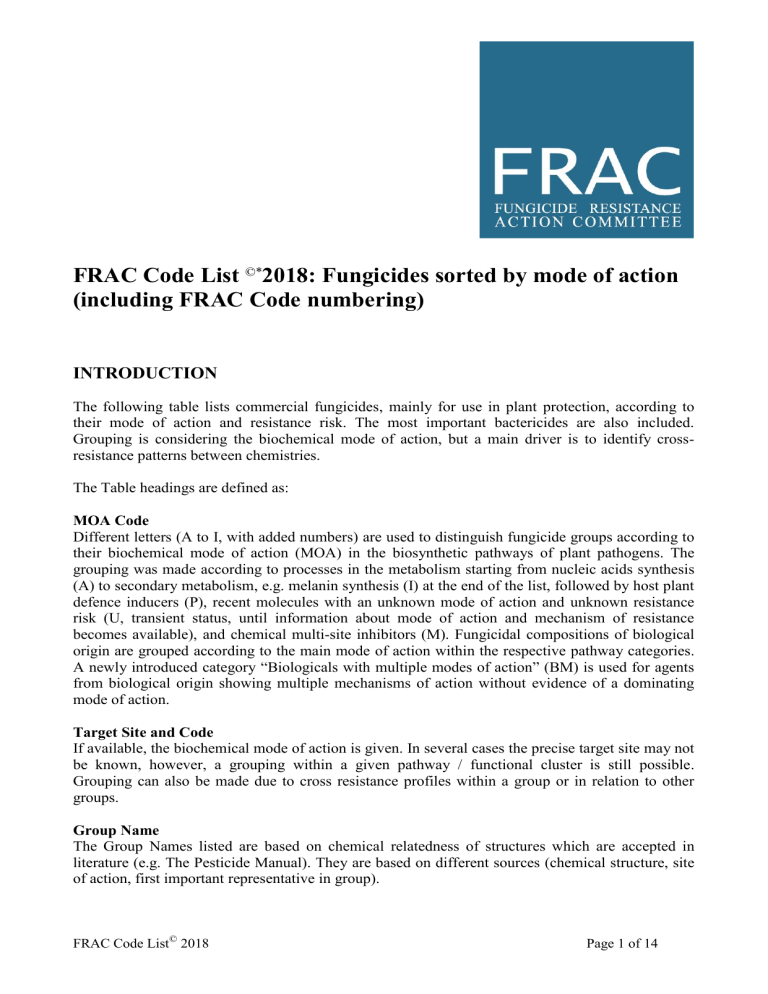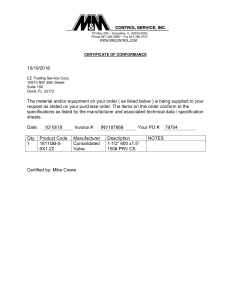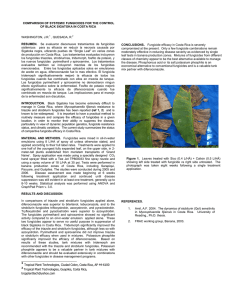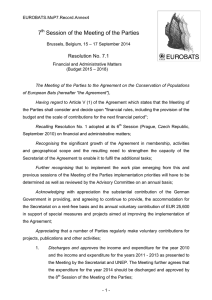
FRAC Code List ©*2018: Fungicides sorted by mode of action (including FRAC Code numbering) INTRODUCTION The following table lists commercial fungicides, mainly for use in plant protection, according to their mode of action and resistance risk. The most important bactericides are also included. Grouping is considering the biochemical mode of action, but a main driver is to identify crossresistance patterns between chemistries. The Table headings are defined as: MOA Code Different letters (A to I, with added numbers) are used to distinguish fungicide groups according to their biochemical mode of action (MOA) in the biosynthetic pathways of plant pathogens. The grouping was made according to processes in the metabolism starting from nucleic acids synthesis (A) to secondary metabolism, e.g. melanin synthesis (I) at the end of the list, followed by host plant defence inducers (P), recent molecules with an unknown mode of action and unknown resistance risk (U, transient status, until information about mode of action and mechanism of resistance becomes available), and chemical multi-site inhibitors (M). Fungicidal compositions of biological origin are grouped according to the main mode of action within the respective pathway categories. A newly introduced category “Biologicals with multiple modes of action” (BM) is used for agents from biological origin showing multiple mechanisms of action without evidence of a dominating mode of action. Target Site and Code If available, the biochemical mode of action is given. In several cases the precise target site may not be known, however, a grouping within a given pathway / functional cluster is still possible. Grouping can also be made due to cross resistance profiles within a group or in relation to other groups. Group Name The Group Names listed are based on chemical relatedness of structures which are accepted in literature (e.g. The Pesticide Manual). They are based on different sources (chemical structure, site of action, first important representative in group). FRAC Code List© 2018 Page 1 of 14 Chemical Group Grouping is based on chemical considerations. Nomenclature is according to IUPAC and Chemical Abstract name. Common name BSI/ISO accepted (or proposed) common name for an individual active ingredient expected to appear on the product label as definition of the product. Comments on Resistance Details are given for the (molecular) mechanism of resistance and the resistance risk. If fieldresistance is known to one member of the Group, it is most likely but not exclusively valid that cross resistance to other group members will be present. There is increasing evidence that the degree of cross resistance can differ between group members and pathogen species or even within species. For the latest information on resistance and cross resistance status of a particular pathogen / fungicide combination, it is advised to contact local FRAC representatives, product manufacturer’s representatives or crop protection advisors. The intrinsic risk for resistance evolution to a given fungicide group is estimated to be low, medium or high according to the principles described in FRAC Monographs 1, 2 and 3. Resistance management is driven by intrinsic risk of fungicide, pathogen risk and agronomic risk (see FRAC pathogen risk list). Similar classification lists of fungicides have been published by T. Locke on behalf of FRAG – UK (Fungicide Resistance, August 2001), and by P. Leroux (Classification des fongicides agricoles et résistance, Phytoma, La Défense des Végétaux, No. 554, 43-51, November 2002). FRAC Code Numbers and letters are used to distinguish the fungicide groups according to their cross resistance behaviour. This code should be used to define the GROUP Number on product labels. The numbers were assigned primarily according to the time of product introduction to the market. The letters refer to P = host plant defence inducers, M = chemical multi-site inhibitors, U = unknown mode of action and unknown resistance risk, and BM = biologicals with multiple modes of action. Reclassification of compounds based on new research may result in codes to expire. This is most likely in the U – section when the mode of actions gets clarified. These codes are not re-used for new groups; a note is added to indicate reclassification into a new code. Last update: February 2018 Next update decisions: January 2019 * Disclaimer The FRAC Code List is the property of FRAC and protected by copyright laws. The FRAC Code List may be used for educational purposes without permission from FRAC. Commercial use of this material may only be made with the express, prior and written permission of FRAC. Inclusion to the FRAC Code List is based on scientific evaluation of the mode of action of the active ingredients; it does not provide any kind of testimonial for the use of a product or a judgment on efficacy. FRAC Code List© 2018 Page 2 of 14 A: nucleic acids metabolism MOA TARGET SITE AND CODE A1 RNA polymerase I A2 adenosindeaminase GROUP NAME CHEMICAL GROUP COMMON NAME acylalanines PA – fungicides (PhenylAmides) hydroxy(2-amino-) pyrimidines A3 DNA/RNA synthesis heteroaromatics (proposed) benalaxyl benalaxyl-M (=kiralaxyl) furalaxyl metalaxyl metalaxyl-M (=mefenoxam) oxazolidinones oxadixyl butyrolactones ofurace hydroxy(2-amino-) pyrimidines bupirimate dimethirimol ethirimol isoxazoles hymexazole isothiazolones octhilinone A4 DNA topoisomerase type II (gyrase) FRAC Code List© 2018 carboxylic acids carboxylic acids oxolinic acid COMMENTS FRAC CODE Resistance and cross resistance well known in various Oomycetes but mechanism unknown. High risk. See FRAC Phenylamide Guidelines for resistance management 4 Medium risk. Resistance and cross resistance known in powdery mildews. Resistance management required. 8 Resistance not known. 32 Bactericide. Resistance known. Risk in fungi unknown. Resistance management required. 31 Page 3 of 14 MOA TARGET SITE AND CODE GROUP NAME CHEMICAL GROUP COMMON NAME benzimidazoles MBC fungicides (Methyl ß-tubulin assembly Benzimidazole in mitosis Carbamates) B: Cytoskeleton and motor protein B1 B2 ß-tubulin assembly in mitosis N-phenyl carbamates thiophanates N-phenyl carbamates COMMENTS FRAC CODE Resistance common in many fungal species. Several target site mutations, mostly E198A/G/K, F200Y in β-tubulin gene. Positive cross resistance between the group members. Negative cross resistance to Nthiophanate Phenylcarbamates. thiophanate-methyl High risk. See FRAC Benzimidazole Guidelines for resistance management. Resistance known. Target site mutation E198K. Negative cross diethofencarb resistance to benzimidazoles. High risk. Resistance management required. benomyl carbendazim fuberidazole thiabendazole B3 benzamides toluamides zoxamide ß-tubulin assembly in mitosis thiazole carboxamide ethylamino-thiazolecarboxamide phenylureas benzamides 10 ethaboxam Low to medium risk. Resistance management required. 22 phenylureas pencycuron Resistance not known. 20 pyridinylmethylbenzamides fluopicolide Resistance not known. 43 B4 cell division (unknown site) 1 B5 delocalisation of spectrin-like proteins cyanoacrylates aminocyanoacrylates phenamacril B6 actin/myosin/fimbrin function benzophenone metrafenone aryl-phenylketones benzoylpyridine pyriofenone Resistance known in Fusarium graminearum. Target site mutations in the gene coding for myosin-5 found in lab studies. Medium to high risk. Resistance management required. Less sensitive isolates detected in wheat powdery mildew. Medium risk. Resistance management required. Reclassified from U8 in 2018 FRAC Code List© 2018 Page 4 of 14 47 50 MOA TARGET SITE AND CODE C1 complex I NADH Oxido-reductase GROUP NAME CHEMICAL GROUP COMMON NAME pyrimidinamines pyrimidinamines diflumetorim pyrazole-MET1 pyrazole-5carboxamides tolfenpyrad quinazoline quinazoline fenazaquin phenyl-benzamides benodanil flutolanil mepronil phenyl-oxo-ethyl thiophene amide pyridinyl-ethylbenzamides furan- carboxamides oxathiincarboxamides thiazolecarboxamides C2 C. respiration SDHI (Succinatecomplex II: succinate-dehydro- dehydrogenase inhibitors) genase pyrazole-4carboxamides N-cyclopropyl-Nbenzyl-pyrazolecarboxamides N-methoxy-(phenylethyl)-pyrazolecarboxamides pyridinecarboxamides pyrazinecarboxamides COMMENTS FRAC CODE Resistance not known. 39 isofetamid fluopyram fenfuram carboxin oxycarboxin thifluzamide benzovindiflupyr bixafen fluindapyr fluxapyroxad furametpyr inpyrfluxam isopyrazam penflufen penthiopyrad sedaxane Resistance known for several fungal species in field populations and lab mutants. Target site mutations in sdh gene, e.g. H/Y (or H/L) at 257, 267, 272 or P225L, dependent on fungal species. Resistance management required. Medium to high risk. See FRAC SDHI Guidelines for resistance management. isoflucypram pydiflumetofen boscalid pyraziflumid azoxystrobin coumoxystrobin enoxastrobin methoxy-acrylates flufenoxystrobin Resistance known in various picoxystrobin fungal species. Target site pyraoxystrobin mutations in cyt b gene (G143A, methoxy-acetamide mandestrobin F129L) and additional C3 pyraclostrobin mechanisms. methoxy-carbamates pyrametostrobin complex III: triclopyricarb cytochrome bc1 QoI-fungicides Cross resistance shown kresoxim-methyl (ubiquinol oxidase) (Quinone outside oximino-acetates between all members of the QoI trifloxystrobin at Qo site (cyt b Inhibitors) group. dimoxystrobin gene) fenaminstrobin High risk. oximino-acetamides metominostrobin orysastrobin See FRAC QoI Guidelines oxazolidine-diones famoxadone for resistance management. dihydro-dioxazines fluoxastrobin Imidazolinones fenamidone benzyl-carbamates FRAC Code List© 2018 7 pyribencarb Page 5 of 14 11 MOA TARGET SITE AND CODE GROUP NAME CHEMICAL GROUP COMMON NAME cyazofamid sulfamoyl-triazole amisulbrom picolinamides fenpicoxamid No spectrum overlap with Oomycete fungicides cyazofamid and amisulbrom C5 dinitrophenylcrotonates Resistance not known. Also acaricidal activity. uncouplers of oxidative phosphorylation binapacryl meptyldinocap dinocap 2,6-dinitro-anilines fluazinam Low risk. However, resistance claimed in Botrytis in Japan. (pyr.-hydrazones) (ferimzone) Reclassified to U 14 in 2012. organo tin compounds tri-phenyl tin compounds fentin acetate fentin chloride fentin hydroxide Some resistance cases known. Low to medium risk. 30 thiophenecarboxamides thiophenecarboxamides silthiofam Resistance reported. Risk low. 38 ametoctradin Not cross resistant to QoI fungicides. Resistance risk assumed to be medium to high (single site inhibitor). Resistance management required. 45 QiI - fungicides complex III: (Quinone inside cytochrome bc1 Inhibitors) (ubiquinone reductase) at Qi site C: respiration (continued) Resistance risk unknown but assumed to be medium to high (mutations at target site known in model organisms). Resistance management required. FRAC CODE cyano-imidazole C4 C6 inhibitors of oxidative phosphorylation, ATP synthase C7 ATP transport (proposed) C8 QoSI fungicides complex III: (Quinone outside cytochrome bc1 Inhibitor, triazolo-pyrimidylamine (ubiquinone stigmatellin reductase) at Qo site, stigmatellin binding type) binding sub-site D1 D: amino acids and protein synthesis COMMENTS methionine biosynthesis (proposed) (cgs gene) D2 protein synthesis (ribosome, termination step) AP - fungicides (AnilinoPyrimidines) enopyranuronic enopyranuronic acid acid antibiotic antibiotic D3 protein synthesis hexopyranosyl antibiotic (ribosome, initiation step) D4 protein synthesis glucopyranosyl antibiotic (ribosome, initiation step) D5 protein synthesis (ribosome, elongation step) FRAC Code List© 2018 anilino-pyrimidines tetracycline antibiotic cyprodinil mepanipyrim pyrimethanil blasticidin-S hexopyranosyl antibiotic kasugamycin glucopyranosyl antibiotic streptomycin tetracycline antibiotic oxytetracycline 21 29 Resistance known in Botrytis and Venturia, sporadically in Oculimacula. Medium risk. See FRAC Anilinopyrimidine Guidelines for resistance management. Low to medium risk. Resistance management required. Resistance known in fungal and bacterial (P. glumae) pathogens. Medium risk. Resistance management required. Bactericide. Resistance known. High risk. Resistance management required. Bactericide. Resistance known. High risk. Resistance management required. Page 6 of 14 9 23 24 25 41 MOA TARGET SITE AND CODE E1 E: signal transduction signal transduction (mechanism unknown) GROUP NAME CHEMICAL GROUP aryloxyquinoline COMMON NAME quinoxyfen azanaphthalenes quinazolinone proquinazid phenylpyrroles fenpiclonil fludioxonil dicarboximides chlozolinate dimethachlone iprodione procymidone vinclozolin E2 MAP/HistidinePP-fungicides Kinase in osmotic (PhenylPyrroles) signal transduction (os-2, HOG1) E3 MAP/Histidine- dicarboximides Kinase in osmotic signal transduction (os-1, Daf1) FRAC Code List© 2018 COMMENTS Resistance to quinoxyfen known. Medium risk. Resistance management required. Cross resistance found in Erysiphe (Uncinula) necator but not in Blumeria graminis. Resistance found sporadically, mechanism speculative. Low to medium risk. Resistance management required. Resistance common in Botrytis and some other pathogens. Several mutations in OS-1, mostly I365S. Cross resistance common between the group members. Medium to high risk. See FRAC Dicarboximide Guidelines for resistance management. Page 7 of 14 FRAC CODE 13 12 2 MOA TARGET SITE AND CODE GROUP NAME CHEMICAL GROUP F1 F2 F: lipid synthesis or transport / membrane integrity or function phospholipid biosynthesis, methyltransferase F3 cell peroxidation (proposed) F5 COMMENTS phosphorothiolates phosphoro-thiolates dithiolanes dithiolanes edifenphos iprobenfos (IBP) pyrazophos isoprothiolane biphenyl AH-fungicides chloroneb (Aromatic aromatic hydrocarbons dicloran Hydrocarbons) quintozene (PCNB) (chlorophenyls, tecnazene (TCNB) nitroanilines) tolclofos-methyl heteroaromatics 1,2,4-thiadiazoles etridiazole carbamates carbamates iodocarb propamocarb prothiocarb Resistance known in specific fungi. Low to medium risk. Resistance management required if used for risky pathogens. 6 Resistance known in some fungi. Low to medium risk. Cross resistance patterns complex due to different activity spectra. 14 Low to medium risk. Resistance management required. 28 formerly CAA-fungicides Bacillus synonyms for Bacillus amyloliquefaciens amyloliquefaciens are Bacillus strain QST 713 subtilis and B. subtilis var. Bacillus amyloliquefaciens (previous F6 amyloliquefaciens Bacillus sp. and the taxonomic classification). strain FZB24 microbial fungicidal lipopeptides microbial disrupters (Bacillus sp.) Resistance not known. Bacillus produced of pathogen cell amyloliquefaciens membranes strain MBI600 Induction of host plant defence described as additional mode Bacillus amyloliquefaciens of action for strain QST 713 and FZB24 strain D747 extract from Melaleuca alternifolia F7 terpene hydrocarbons, (tea tree) cell membrane plant extract terpene alcohols and Resistance not known. plant oils (mixtures): disruption terpene phenols eugenol, geraniol, (proposed) thymol amphoteric macrolide antifungal antibiotic Resistance not known natamycin F8 polyene from Streptomyces agricultural, food and topical (pimaricin) ergosterol binding natalensis or medical uses. S. chattanoogensis OSBPI Resistance risk assumed to be oxysterol binding medium to high (single site F9 piperidinyl-thiazoleprotein oxathiapiprolin inhibitor). Resistance lipid homeostasis isoxazolines management required. and transfer/storage homologue inhibition (Previously U15). FRAC Code List© 2018 FRAC CODE formerly dicarboximides F4 cell membrane permeability, fatty acids (proposed) COMMON NAME Page 8 of 14 44 46 48 49 MOA TARGET SITE AND CODE GROUP NAME CHEMICAL GROUP COMMON NAME piperazines pyridines pyrimidines imidazoles G: sterol biosynthesis in membranes G1 DMI-fungicides (DeMethylation C14- demethylase Inhibitors) in sterol biosynthesis (SBI: Class I) (erg11/cyp51) triazoles triazolinthiones G2 14-reductase and 87isomerase in sterol biosynthesis (erg24, erg2) amines (“morpholines”) morpholines piperidines fenpropidin piperalin spiroketal-amines G3 KRI fungicides hydroxyanilides (KetoReductase Inhibitors) 3-keto reductase, C4- de-methylation amino-pyrazolinone (SBI: Class III) (erg27) G4 squalene-epoxidase (SBI class IV) in sterol biosynthesis (erg1) FRAC Code List© 2018 triforine pyrifenox pyrisoxazole fenarimol nuarimol There are big differences in the imazalil activity spectra of DMI oxpoconazole fungicides. pefurazoate prochloraz Resistance is known in various triflumizole fungal species. Several azaconazole resistance mechanisms are bitertanol known incl. target site mutations bromuconazole in cyp51 (erg 11) gene, e.g. cyproconazole V136A, Y137F, A379G, I381V; difenoconazole cyp51 promotor; ABC diniconazole transporters and others. epoxiconazole etaconazole Generally wise to accept that fenbuconazole cross resistance is present fluquinconazole between DMI fungicides active flusilazole against the same fungus. flutriafol hexaconazole DMI fungicides are Sterol imibenconazole Biosynthesis Inhibitors (SBIs), ipconazole but show no cross resistance to metconazole other SBI classes. myclobutanil penconazole Medium risk. propiconazole simeconazole See FRAC SBI Guidelines tebuconazole for resistance management. tetraconazole triadimefon triadimenol triticonazole prothioconazole aldimorph dodemorph fenpropimorph tridemorph (SBI: Class II) COMMENTS spiroxamine fenhexamid fenpyrazamine thiocarbamates pyributicarb allylamines naftifine terbinafine Decreased sensitivity for powdery mildews. Cross resistance within the group generally found but not to other SBI classes. FRAC CODE 3 5 Low to medium risk. See FRAC SBI Guidelines for resistance management. Low to medium risk. Resistance management required. 17 Resistance not known, fungicidal and herbicidal activity. 18 Medical fungicides only. Page 9 of 14 H: cell wall biosynthesis MOA TARGET SITE AND CODE GROUP NAME CHEMICAL GROUP COMMON NAME COMMENTS FRAC CODE H3 formerly glucopyranosyl antibiotic (validamycin) reclassified to U18 26 Resistance known. Medium risk. Resistance management required. 19 H4 polyoxins chitin synthase peptidyl pyrimidine nucleoside polyoxin cinnamic acid amides dimethomorph flumorph pyrimorph H5 CAA-fungicides (Carboxylic Acid Amides) cellulose synthase valinamide carbamates mandelic acid amides I: melanin synthesis in cell wall I1 reductase in melanin biosynthesis I2 dehydratase in melanin biosynthesis I3 polyketide synthase in melanin biosynthesis FRAC Code List© 2018 MBI-R (Melanin Biosynthesis Inhibitors – Reductase) MBI-D (Melanin Biosynthesis Inhibitors – Dehydratase) MBI-P (Melanin Biosynthesis Inhibitors – Polyketide synthase) Resistance known in Plasmopara viticola but not in Phytophthora infestans. Cross resistance between all benthiavalicarb members of the CAA group. iprovalicarb Low to medium risk. valifenalate See FRAC CAA Guidelines for resistance management. mandipropamid isobenzo-furanone fthalide pyrrolo-quinolinone pyroquilon triazolobenzothiazole cyclopropanecarboxamide Resistance not known. 40 16.1 tricyclazole carpropamid carboxamide diclocymet propionamide fenoxanil trifluoroethylcarbamate tolprocarb Resistance known. Medium risk. Resistance management required. 16.2 Resistance not known. 16.3 Page 10 of 14 MOA TARGET SITE AND CODE P1 P: host plant defence induction salicylate-related P2 salicylate-related P3 salicylate-related P4 polysaccharide elici0tors P5 anthraquinone elicitors P6 microbial elicitors P7 phosphonates FRAC Code List© 2018 GROUP NAME CHEMICAL GROUP COMMON NAME benzothiadiazole (BTH) COMMENTS FRAC CODE benzo-thiadiazole (BTH) acibenzolar-Smethyl Resistance not known. P01 benzisothiazole benzisothiazole probenazole (also antibacterial and antifungal activity) Resistance not known. P02 thiadiazolecarboxamide thiadiazolecarboxamide tiadinil isotianil Resistance not known. P03 natural compound polysaccharides laminarin Resistance not known. P04 plant extract complex mixture, ethanol extract (anthraquinones, resveratrol) extract from Reynoutria sachalinensis (giant knotweed) Resistance not known. P05 microbial Bacillus cereus group Bacillus mycoides isolate J Resistance not known. P06 ethyl phosphonates phosphonates Few resistance cases reported in few pathogens. Low risk. phosphorous acid Reclassified from U33 in 2018 and salts fosetyl-Al Page 11 of 14 P07 (33) MOA TARGET SITE AND CODE unknown GROUP NAME CHEMICAL GROUP COMMON NAME cyanoacetamideoxime cyanoacetamideoxime cymoxanil COMMENTS Resistance claims described. Low to medium risk. Resistance management required. FRAC CODE 27 U: Unknown mode of action (U numbers not appearing in the list derive from reclassified fungicides) formerly phosphonates (FRAC code 33), reclassified to P 07 in 2018 unknown phthalamic acids phthalamic acids teclofthalam (Bactericide) Resistance not known. 34 unknown benzotriazines benzotriazines triazoxide Resistance not known. 35 unknown benzenesulfonamides benzenesulphonamides flusulfamide Resistance not known. 36 unknown pyridazinones pyridazinones diclomezine Resistance not known. 37 formerly methasulfocarb (FRAC code 42), reclassified to M 12 in 2018 unknown phenylacetamide phenyl-acetamide cyflufenamid Resistance in Sphaerotheca. Resistance management required U06 U12 cell membrane disruption (proposed) guanidines guanidines dodine Resistance known in Venturia inaequalis. Low to medium risk. Resistance management recommended. unknown thiazolidine cyano-methylenethiazolidines flutianil Resistance not known. U13 unknown pyrimidinonehydrazones pyrimidinonehydrazones ferimzone Resistance not known (previously C5). U14 U16 complex III: cytochrome bc1, unknown binding site (proposed) 4-quinolylacetate 4-quinolyl-acetates tebufloquin Not cross resistant to QoI. Resistance risk unknown but assumed to be medium. Resistance management required. Unknown tetrazolyloxime tetrazolyloximes picarbutrazox Resistance not known. Not cross resistant to PA, QoI, CAA. U17 Unknown (Inhibition of trehalase) glucopyranosyl antibiotic glucopyranosyl antibiotics validamycin Resistance not known. Induction of host plant defense by trehalose proposed (previously H3). U18 FRAC Code List© 2018 Page 12 of 14 MOA M: Chemicals with multi-site activity NC: not classified TARGET SITE AND CODE unknown multi-site contact activity FRAC Code List© 2018 GROUP NAME CHEMICAL GROUP COMMON NAME COMMENTS FRAC CODE Resistance not known. NC diverse diverse mineral oils, organic oils, inorganic salts, material of biological origin inorganic (electrophiles) inorganic copper (different salts) M01 inorganic (electrophiles) inorganic sulphur M02 dithiocarbamates and relatives (electrophiles) dithio-carbamates and relatives ferbam mancozeb maneb metiram propineb thiram zinc thiazole zineb ziram M03 phthalimides (electrophiles) phthalimides captan captafol folpet M04 Generally considered as a low risk group without any signs of resistance developing to the fungicides. chloronitriles (phthalonitriles) (unspecified mechanism) chloronitriles (phthalonitriles) chlorothalonil sulfamides (electrophiles) sulfamides dichlofluanid tolylfluanid M06 bis-guanidines guazatine iminoctadine M07 triazines anilazine M08 quinones (anthraquinones) (electrophiles) quinones (anthra-quinones) dithianon M09 quinoxalines (electrophiles) quinoxalines chinomethionat / quinomethionate M10 maleimide (electrophiles) maleimide fluoroimide M11 thiocarbamate (electrophiles) thiocarbamate methasulfocarb bis-guanidines (membrane disruptors, detergents) triazines (unspecified mechanism) Reclassified from U42 in 2018 Page 13 of 14 M05 M12 MOA TARGET SITE BM: Biologicals with multiple modes of action multiple effects on cell wall, ion membrane transporters; chelating effects polypeptide (from plant extract) competition, mycoparasitism, antibiosis, lytic enzymes and induced resistance microbial (Trichoderma spp.) FRAC Code List© 2018 GROUP NAME CHEMICAL GROUP COMMON NAME COMMENTS FRAC CODE polypeptide (lectin) extract from the cotyledons of lupine plantlets (“BLAD”) Resistance not known (previously M12). BM01 Trichoderma spp. and the fungicidal metabolites produced Trichoderma atroviride strain SC1 Resistance not known BM02 Page 14 of 14



